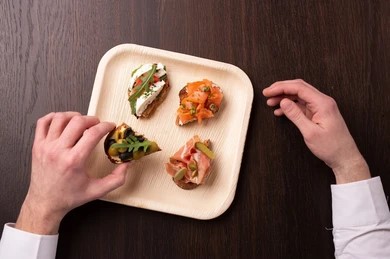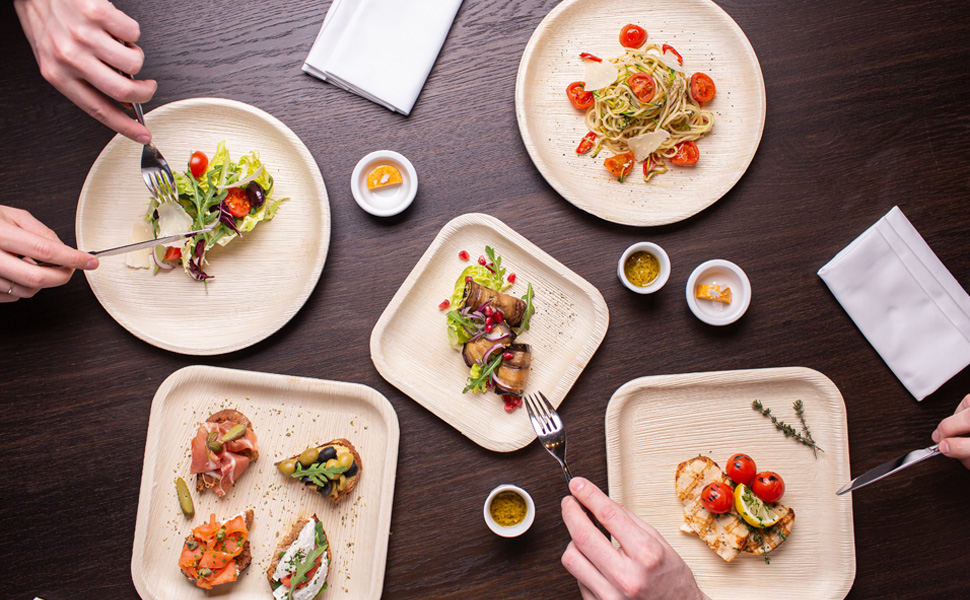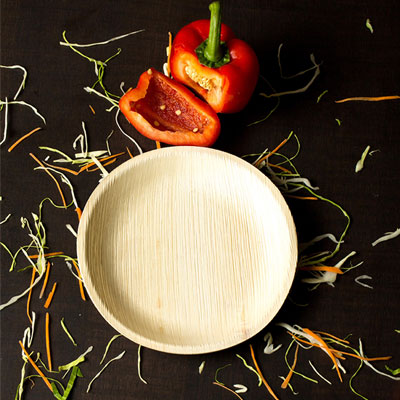Introduction to Palm Leaf Dining
In the quest for sustainable living, every choice matters, especially those concerning our dining habits. Palm leaf dining presents a compelling, eco-friendly alternative to traditional tableware, merging aesthetic appeal with environmental stewardship. This guide delves into the world of palm leaf dining, exploring its origins, benefits, and practical applications.
The Origins of Palm Leaf Products
Historical Context
Historically, palm leaves were used in various cultures for a multitude of purposes, not just limited to dining. In India, for instance, dried palm leaves were used as a writing surface long before paper became the norm. Similarly, in parts of Africa, Asia, and Latin America, palm leaves have been fashioned into roofing materials, baskets, and other household items for centuries. The use of palm leaves in dining specifically can be traced back to these areas where the palm tree is not just a plant, but a vital component of daily life.
Geographical Spread
The practice of using palm leaves for plates, bowls, and utensils spread throughout regions where palm trees were abundant. This natural abundance meant that communities could rely on a steady supply of leaves without harming the environment, as only fallen leaves were collected for use, ensuring the sustainability of the practice. The method was simple yet effective: leaves were gathered, cleaned, and then shaped into the desired form through a process of heating and pressing. This eco-friendly approach to dining ware made from palm leaves gradually gained popularity beyond its traditional regions as global awareness of sustainability grew.
Cultural Significance
In many cultures, palm leaf products are not just utilitarian items but carry significant cultural and religious importance. For example, in Hindu rituals and ceremonies, palm leaves are used to serve food, symbolizing purity and natural harmony. The eco-conscious philosophy embedded in such practices highlights a deep respect for nature and an understanding of the interconnectedness of all life.
Modern Relevance
Today, the relevance of palm leaf products has been rediscovered in the context of environmental sustainability. As the world grapples with pollution and waste from single-use plastics and non-biodegradable materials, the ancient wisdom of using palm leaves presents a viable solution. Modern production methods have adapted the traditional techniques for a global market, making palm leaf dining ware more accessible while still maintaining its eco-friendly essence.

Benefits of Palm Leaf Dining
Environmental Impact
One of the most compelling reasons to choose palm leaf dining ware is its minimal environmental footprint. Palm leaves are a natural, renewable resource that biodegrades quickly and completely, unlike plastic or other non-biodegradable materials that contribute to landfill waste and pollution. Since palm leaf products are made from fallen leaves that are collected, cleaned, and molded into shape without the need for chemicals or synthetic additives, their production process is inherently eco-friendly. This sustainable lifecycle reduces waste and conserves resources, aligning with the principles of circular economy and environmental stewardship.
Health and Safety
Palm leaf dining ware is free from the chemicals and toxins found in some plastic and synthetic products, making them a safer choice for serving food. The natural composition of palm leaves means there are no harmful bisphenols (such as BPA), phthalates, or other substances that can leach into food, particularly when exposed to heat. This ensures that meals served on palm leaf plates remain as healthy and safe to consume as they are intended to be, offering peace of mind for consumers who are cautious about chemical exposure from dining ware.
Aesthetic and Practicality
Beyond their environmental and health benefits, palm leaf products bring an earthy, elegant aesthetic to the dining table that is hard to replicate with other materials. Each piece is unique, with its own natural grain and texture, adding a touch of rustic charm to any meal setting. This distinct appearance makes palm leaf dining ware especially popular for events like weddings, parties, and other special occasions where presentation is key. Moreover, palm leaf plates and bowls are surprisingly durable and heat-resistant, capable of handling both hot and cold foods, and can even be used in the microwave for short periods. This practicality, combined with their visual appeal, makes palm leaf products a versatile choice for a wide range of dining experiences.

How Palm Leaf Products Are Made
Collection of Fallen Leaves
The first step involves collecting fallen leaves from palm trees, primarily the Areca palm, which is commonly found in tropical and subtropical regions. This method is inherently sustainable, as it does not require the felling of trees or harm to the ecosystem. Workers gather these leaves, which would otherwise decompose and go to waste, providing a source of raw material that is renewable and environmentally friendly.
Cleaning and Sanitizing
Once collected, the leaves are thoroughly cleaned with water to remove any dirt and debris. After cleaning, they undergo a sanitizing process, often using natural, non-chemical methods to ensure they are safe for food contact. This step is crucial for maintaining the hygienic quality of the final products without introducing harmful substances into the process.
Shaping and Molding
The clean and sanitized leaves are then subjected to heat and pressure, which transforms them into the desired shapes and sizes, such as plates, bowls, and trays. This process is typically done using hydraulic presses that mold the leaves into various forms while simultaneously sterilizing them with heat. The heat and pressure cause the natural sap within the leaves to act as a binding agent, ensuring the products retain their shape without the need for additional adhesives or binders.
Trimming and Finishing
After molding, the edges of the palm leaf products are trimmed to create a smooth, uniform appearance. This step also involves checking each item for quality and strength, ensuring that they meet the required standards for durability and functionality. The finishing process may also include a final cleaning or polishing to enhance the natural beauty of the palm leaf patterns, making each piece uniquely attractive.
Packaging and Distribution
Once completed, the palm leaf products are packaged and prepared for distribution. The packaging is often eco-friendly as well, aligning with the sustainable ethos of the products themselves. They are then shipped to retailers, restaurants, event planners, and consumers who are looking for environmentally responsible dining options.

Palm Leaf Dining in Modern Culinary Practices
Use in Restaurants
Many restaurants, especially those focusing on organic, local, and sustainable food practices, have embraced palm leaf tableware as part of their commitment to reducing environmental impact. The aesthetic appeal of palm leaf plates complements the presentation of dishes, adding an element of natural beauty that aligns with the ethos of farm-to-table dining. Additionally, for establishments seeking to differentiate themselves, the use of unique and eco-friendly tableware can be a talking point and draw for environmentally conscious consumers.
Integration in Events
Event planners and caterers are increasingly turning to palm leaf products for weddings, corporate events, and private parties. The demand for sustainable event planning solutions has risen sharply, with clients looking to minimize their ecological footprint while hosting. Palm leaf dining ware offers a practical and visually appealing option, serving as a testament to the host’s commitment to sustainability. Its versatility and durability make it suitable for a wide range of culinary styles and settings, from outdoor barbecues to elegant receptions.
Popularity Among Consumers
The trend towards sustainability has also influenced consumer behavior, with more individuals seeking out eco-friendly products for home use. Palm leaf dining ware has found its way into households as an alternative to disposable plastic or paper products for gatherings, parties, or everyday dining. The appeal of using natural, compostable materials that don’t contribute to landfill waste has driven its popularity among eco-conscious consumers.
Collaboration with Chefs and Culinary Artists
Some chefs and culinary artists have adopted palm leaf tableware as a canvas for their creations, drawn to its unique texture and appearance. This collaboration showcases the versatility of palm leaf products, proving that sustainability does not come at the expense of creativity or culinary excellence. The natural patterns and colors of palm leaf plates can enhance the visual presentation of dishes, adding an extra dimension to the dining experience.
Education and Awareness
The use of palm leaf dining ware also serves an educational role, raising awareness among diners about sustainable practices and the impact of their choices. Restaurants and events that utilize palm leaf products often take the opportunity to inform their guests about the environmental benefits of these choices, fostering a broader understanding and appreciation for sustainability in the culinary world.
Comparing Palm Leaf with Other Eco-friendly Alternatives
Bamboo
Bamboo is a highly renewable resource known for its strength, durability, and natural aesthetic. Like palm leaf, bamboo products are biodegradable and compostable, making them an environmentally friendly option. Bamboo grows quickly, requires no fertilizers, and can be harvested without killing the plant, ensuring a sustainable supply. However, the manufacturing process for bamboo products can be more complex and energy-intensive than for palm leaf, potentially increasing their environmental footprint. Additionally, bamboo items are often more expensive due to the processing involved.
Recycled Paper
Recycled paper products offer a way to reduce waste and repurpose paper into new items, including plates, cups, and utensils. These products are widely available and often cost less than other eco-friendly alternatives. While recycled paper dining ware is biodegradable and better for the environment than virgin paper products, the recycling process itself requires water and energy, and some products may be coated with plastics or waxes to enhance durability, which can complicate composting.
Bioplastics
Bioplastics are made from renewable biomass sources, such as corn starch, sugarcane, or potato starch, making them a more sustainable alternative to traditional petroleum-based plastics. Bioplastics can be engineered to be biodegradable or compostable, reducing their impact on landfills and oceans. However, the environmental benefits of bioplastics can vary significantly depending on the specific materials used and the conditions under which they are composted. Some bioplastics require industrial composting facilities to break down, which may not be readily accessible in all areas. Additionally, the production of bioplastics competes with food production for resources and land.
Comparison Summary
- Environmental Impact: Palm leaf and bamboo are both highly sustainable, with minimal environmental footprints. Recycled paper reduces waste, but its production and the presence of non-compostable coatings can lessen its eco-friendliness. Bioplastics offer a renewable alternative to traditional plastics, but their impact depends on the resources used and composting conditions.
- Usability and Aesthetics: Palm leaf products are unique in appearance and strong enough for a variety of uses, adding a rustic charm to dining experiences. Bamboo shares similar aesthetic and durability qualities. Recycled paper products are versatile but may lack the strength and heat resistance of palm leaf and bamboo. Bioplastics resemble conventional plastics in use and appearance, offering a familiar dining experience with reduced environmental guilt.
- Cost: Bamboo and palm leaf products tend to be more expensive than recycled paper and some bioplastics due to their natural origins and the processes involved in their production. However, the cost is often justified by their sustainability and aesthetic appeal.

How to Incorporate Palm Leaf Dining into Your Lifestyle
At Home
- Daily Meals: Swap out traditional plastic or ceramic plates for palm leaf alternatives for everyday meals. This simple change can significantly reduce your household’s reliance on non-renewable resources and introduce a natural vibe to your dining table.
- Special Occasions: Use palm leaf tableware for birthdays, anniversaries, or any celebratory event. The distinctive look of palm leaf products can elevate the ambiance of your gatherings, making them memorable and eco-friendly.
- Outdoor Dining: Palm leaf plates and bowls are perfect for picnics, barbecues, and outdoor parties. Their durability and compostability make them an excellent choice for events where disposable tableware is needed, without the environmental guilt associated with plastic disposables.
Hosting and Entertainment
- Dinner Parties: Impress your guests by serving meals on palm leaf tableware. It’s a conversation starter and a way to spread awareness about sustainable living. Pairing beautiful, natural tableware with your culinary creations can enhance the overall dining experience.
- Themed Events: For themed parties, such as a tropical or eco-friendly theme, palm leaf dining ware is the perfect fit. It complements the theme while aligning with the principles of sustainability and environmental consciousness.
- Cooking Classes or Workshops: If you host cooking classes or food-related workshops, using palm leaf products can underscore lessons about sustainability in food preparation and presentation.
Lifestyle and Advocacy
- Gift Giving: Consider giving palm leaf tableware sets as gifts for housewarmings, weddings, or holidays. It’s a thoughtful way to promote eco-friendly practices among friends and family.
- Educational Opportunities: Use your choice of palm leaf dining ware as an opportunity to educate others about sustainability. Whether it’s a casual conversation at a dinner party or a social media post, sharing information about the benefits of palm leaf products can inspire others to make eco-friendly choices.
- Supporting Sustainable Brands: By choosing palm leaf products, you’re supporting businesses that prioritize sustainability. Look for brands that are transparent about their manufacturing processes and committed to ethical practices, furthering your impact on promoting a greener economy.
Practical Considerations
- Storage and Care: While palm leaf plates and bowls are durable, they are best stored in a dry place to maintain their integrity. Although disposable, they can often withstand light hand washing and reuse for dry or semi-dry foods.
- Composting: After use, palm leaf tableware can be composted, turning into nutrient-rich soil. If you have a home compost bin, add your used palm leaf products to it. If not, look for local composting facilities that accept biodegradable materials.

Conclusion
Palm leaf dining offers a sustainable, stylish, and practical solution to the environmental challenges posed by conventional tableware. By choosing palm leaf products, we not only enhance our dining experience but also contribute to a healthier planet.
FAQs
- How long do palm leaf plates last?
- Are palm leaf products compostable?
- Can palm leaf plates be used for all types of food?
- How does the cost of palm leaf dining compare to traditional tableware?
- Where can I purchase palm leaf dining products?
